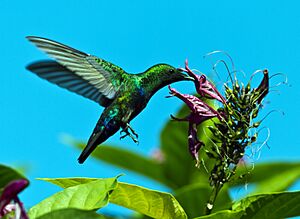Green-throated carib facts for kids
Quick facts for kids Green-throated carib |
|
|---|---|
 |
|
| in Barbados | |
| Conservation status | |
| Scientific classification | |
| Genus: |
Eulampis
|
| Species: |
holosericeus
|
 |
|
| Synonyms | |
|
Trochilus holosericeus Linnaeus, 1758 |
|
The green-throated carib is a type of hummingbird that lives in the Caribbean. You can find it in places like Puerto Rico and many of the Lesser Antilles islands. Its scientific name is Eulampis holosericeus.
Contents
Discovering the Green-throated Carib
Scientists give every animal a special name. This helps everyone know exactly which animal they are talking about. The green-throated carib was first officially described in 1758 by a Swedish scientist named Carl Linnaeus. He gave it the name Trochilus holosericeus.
Later, scientists placed this hummingbird in a group called Eulampis. It shares this group with another bird, the purple-throated carib. The name holosericeus comes from an ancient Greek word meaning "silken," likely describing its smooth feathers.
Different Types of Green-throated Caribs
There are two main types, or subspecies, of the green-throated carib:
- E. h. holosericeus: This is the most common type.
- E. h. chlorolaemus: This type is found only on the island of Grenada.
What Does the Green-throated Carib Look Like?
The green-throated carib is a fairly large hummingbird. It is about 10.5 to 12 centimeters (4 to 4.7 inches) long.
Both male and female birds have a bright green back. The female's green is a bit duller. They also have a shiny green patch on their throat, called a gorget. The male's gorget has a blue edge, but it can be hard to see.
Their bellies are black, and the area near their tail is green. Their tail is a dark blue color, which can look black in dim light. The type of carib found on Grenada has slightly darker underparts.
Males have a bill that curves down a little. Females have a longer, more curved bill.
Sounds They Make
Green-throated caribs make a sharp "chup!" or "chuwp!" sound. When they are fighting over their territory, they might also make rattling or whirring sounds with their wings.
Where Do Green-throated Caribs Live?
These hummingbirds usually stay in one area. However, some might move to wetter places after they have had their babies.
The most common type of green-throated carib lives from eastern Puerto Rico through the Virgin Islands. You can find them all the way down the Lesser Antilles chain, but not on Grenada. The other type, E. h. chlorolaemus, lives only on Grenada.
Their Favorite Places to Live
Green-throated caribs live in many different kinds of places. They like wet forests, forests where some trees lose their leaves, and even gardens and parks. On the island of Martinique, they can also be found in drier areas. On many islands, they are most common near the sea. But on Dominica, they prefer living in the hills.
How Green-throated Caribs Behave
What They Eat
Green-throated caribs drink nectar from many different kinds of flowering plants and trees. Male hummingbirds often protect areas with flowers all year long. Females do this only when they are not raising young.
These birds also eat small arthropods, like insects and spiders. They usually catch these tiny creatures while flying.
Reproduction and Life Cycle
Green-throated caribs are thought to build their nests and lay eggs between March and July. This timing might depend on when it rains.
Their nest is shaped like a cup. It is made of soft fibers on the inside, with lichen and bark pieces stuck to the outside. Nests are usually placed in the fork of a tree branch, about 2 to 9 meters (7 to 30 feet) above the ground.
A female carib usually lays two eggs. The eggs hatch in about 17 to 19 days. The young birds are ready to leave the nest about 20 to 22 days after hatching. These hummingbirds can start having their own babies when they are two years old. They might even nest twice in one year.
Are Green-throated Caribs Safe?
The IUCN (International Union for Conservation of Nature) says the green-throated carib is a species of "Least Concern." This means they are not currently in danger of disappearing. We do not know exactly how many there are or if their numbers are growing or shrinking.
Even though they live in a small area, they are common in many parts of it. These birds can live well in places changed by humans, like gardens and areas around homes. However, scientists are still learning about how they move around. Breaking up their natural homes into smaller pieces could be a problem for them in the future.


